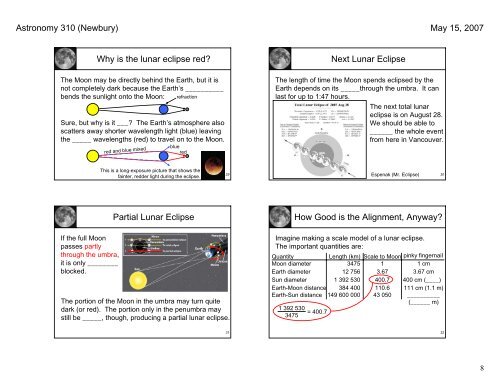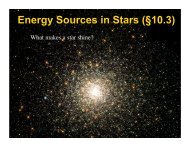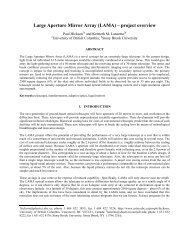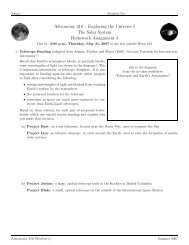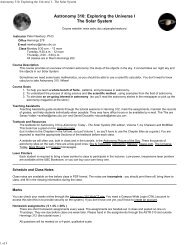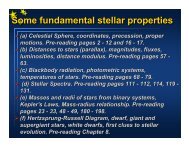The Motion of the Moon The Moon The Earth, Sun, and Time of Day
The Motion of the Moon The Moon The Earth, Sun, and Time of Day
The Motion of the Moon The Moon The Earth, Sun, and Time of Day
- No tags were found...
You also want an ePaper? Increase the reach of your titles
YUMPU automatically turns print PDFs into web optimized ePapers that Google loves.
Astronomy 310 (Newbury)<br />
May 15, 2007<br />
Why is <strong>the</strong> lunar eclipse red<br />
<strong>The</strong> <strong>Moon</strong> may be directly behind <strong>the</strong> <strong>Earth</strong>, but it is<br />
not completely dark because <strong>the</strong> <strong>Earth</strong>’s __________<br />
bends <strong>the</strong> sunlight onto <strong>the</strong> <strong>Moon</strong>: refraction<br />
Sure, but why is it ___ <strong>The</strong> <strong>Earth</strong>’s atmosphere also<br />
scatters away shorter wavelength light (blue) leaving<br />
<strong>the</strong> _____ wavelengths (red) to travel on to <strong>the</strong> <strong>Moon</strong>.<br />
red <strong>and</strong> blue mixed<br />
blue<br />
red<br />
Next Lunar Eclipse<br />
<strong>The</strong> length <strong>of</strong> time <strong>the</strong> <strong>Moon</strong> spends eclipsed by <strong>the</strong><br />
<strong>Earth</strong> depends on its _____through <strong>the</strong> umbra. It can<br />
last for up to 1:47 hours.<br />
<strong>The</strong> next total lunar<br />
eclipse is on August 28.<br />
We should be able to<br />
______ <strong>the</strong> whole event<br />
from here in Vancouver.<br />
This is a long-exposure picture that shows <strong>the</strong><br />
fainter, redder light during <strong>the</strong> eclipse.<br />
29<br />
Espenak (Mr. Eclipse)<br />
30<br />
If <strong>the</strong> full <strong>Moon</strong><br />
passes partly<br />
through <strong>the</strong> umbra,<br />
it is only ________<br />
blocked.<br />
Partial Lunar Eclipse<br />
<strong>The</strong> portion <strong>of</strong> <strong>the</strong> <strong>Moon</strong> in <strong>the</strong> umbra may turn quite<br />
dark (or red). <strong>The</strong> portion only in <strong>the</strong> penumbra may<br />
still be _____, though, producing a partial lunar eclipse.<br />
How Good is <strong>the</strong> Alignment, Anyway<br />
Imagine making a scale model <strong>of</strong> a lunar eclipse.<br />
<strong>The</strong> important quantities are:<br />
Quantity<br />
Length (km) Scale to <strong>Moon</strong> pinky fingernail<br />
<strong>Moon</strong> diameter<br />
3475 1<br />
1 cm<br />
<strong>Earth</strong> diameter<br />
12 756 3.67 3.67 cm<br />
<strong>Sun</strong> diameter 1 392 530 400.7 400 cm (____)<br />
<strong>Earth</strong>-<strong>Moon</strong> distance 384 400 110.6 111 cm (1.1 m)<br />
<strong>Earth</strong>-<strong>Sun</strong> distance 149 600 000 43 050 __________<br />
(______ m)<br />
1 392 530<br />
= 400.7<br />
3475<br />
31<br />
32<br />
8


